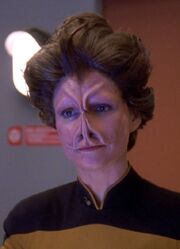 |
Warning! This page contains information regarding Star Trek: Lower Decks, and thus may contain spoilers.
|
Starfleet was the deep space exploratory and defense service maintained by the United Federation of Planets. Its principal functions included the advancement of Federation knowledge about the galaxy and its inhabitants, and knowledge of all areas of study, both scientific and non-scientific. Starfleet's ancillary duties included the defense of the Federation and the facilitation of Federation diplomacy.
Starfleet personnel were frequently brought into contact with cultures and sentient species whose existences were unknown to the Federation. Starfleet officers therefore acted as official representatives of the Federation in these cases. Starfleet vessels were also frequently used to ferry ambassadors on diplomatic missions. (TNG: "The Last Outpost", "Conspiracy"; VOY: "Innocence", "The Void"; TOS: "Journey to Babel"; Star Trek)
History[]
United Earth[]

United Earth Starfleet Flag (22nd century)
Starfleet was established by the original Starfleet Charter in or around the 2130s as an Earth-based space exploration organization. (ENT: "Vox Sola", "Horizon", "Twilight") The highest authority within Starfleet was Starfleet Command, located at Starfleet Headquarters in the city of San Francisco, Earth. (ENT: "Broken Bow", "Terra Prime", "Shockwave", "Shockwave, Part II") Starfleet Command had authority to administer projects and missions, issue orders to Starfleet officers and vessels, restrict access to certain facilities, and approve security protocols. Certain flag officers, such as Maxwell Forrest, reported directly to Starfleet Command. (ENT: "Singularity", "The Catwalk", "First Flight", "Cold Station 12")

Starfleet Command/UESPA logo
It is unclear exactly when Starfleet was established. Jonathan Archer considered joining the Earth Cargo Service a few years before Starfleet was chartered, and 2134 was his senior year in college. (ENT: "Vox Sola", "Horizon") Starfleet must have existed in 2136, as Margaret Mullin turned down Archer's proposal of marriage, not wanting to become a "Starfleet widow." (ENT: "Twilight") The series bible for Star Trek: Enterprise referred to the organization as having been in existence for "less than twenty years" by 2151. Brannon Braga once said of Starfleet, "It's only been around for a decade or more [as of 2151]." (Broken Bow, paperback ed., p. 250)
In as little as a decade after its original founding, Starfleet had expanded considerably, dividing itself into three major branches commonly known as Command, Engineering-Security, and Science-Medical. In the 2140s, Starfleet adopted a uniform color scheme of gold, red, and blue which would remain relatively unchanged until the 2270s (ENT: "Broken Bow"; Star Trek: The Motion Picture). By the same time, Starfleet had formed several major offices such as Starfleet Command, Starfleet Medical, and Starfleet Engineering. (ENT: "First Flight")
The Starfleet Training Command was founded in the early 2140s to standardize training of Starfleet personnel as well as screen and train candidates for commissioning as Starfleet officers. What few spaceships Starfleet had in the 2140s and 50s answered directly to Starfleet Operations. By the 2150s, Starfleet had also formed its own information gathering service, known as Starfleet Intelligence. (ENT: "Observer Effect", "Demons", "Cold Front")
One of Starfleet's earliest major projects was the NX Project (an offshoot from the Warp Five program), which aimed to develop a viable and fast interstellar engine that would allow Earth ships to cross vast distances in a reasonably short amount of time. Despite some allegations of Vulcan interference (or simply lack of assistance), Earth was eventually able to perfect the warp five engine, with Enterprise NX-01, the first Starfleet vessel to be carry the engine, launched in 2151. Under the command of Captain Jonathan Archer, Enterprise played a large part in the establishment of Earth as an interstellar power, negotiating treaties between the Vulcans and Andorians in 2152; saving the galaxy from the Sphere-Builders and the Xindi in 2154; uncovering the lost teachings of Surak on Vulcan and preventing a Vulcan invasion of Andoria later in 2154; helping to instigate a cultural and political coup d'état against Administrator V'Las, the dictatorial Vulcan head of state; and facilitating peace talks between the Andorians and Tellarites following a series of attacks on both races in late 2154. Throughout its tenure, Enterprise made first contact with over thirty species. (ENT: "Broken Bow", "Cease Fire", "Zero Hour", "The Forge", "Awakening", et al.)
Following the Xindi incident, Earth experienced a brief period of xenophobia, during which not all Humans supported Starfleet's objectives and policies. In one incident encountered by the crew of Enterprise, they were informed by one Human civilian that "You Starfleet people are the real problem. You fly all around space telling every species you meet where to find Earth. Did it ever occur to you that might not be the smartest thing to do?" (ENT: "Home")
Some Starfleet personnel worked in conjunction with the United Earth Diplomatic Corps. (ENT: "The Forge")
For a time, beginning in 2153, some Starfleet vessels began carrying detachments of MACOs, an Earth military service. This practice was a reaction to the devastating Xindi attack on Earth and the dangers encountered during the resulting mission into the Delphic Expanse. The decision to carry these units was left up to individual starship captains, and was not a formal policy of Starfleet Command at the time. In 2154, Jonathan Archer advised the captain of Columbia NX-02, Hernandez, to ask for a squad of MACOs. Enterprise had MACO units assigned to its mission as late as 2161. (ENT: "The Expanse", "Home", "These Are the Voyages...")
Article 14, Section 31, of the original Starfleet Charter made allowances for certain rules to be bent during times of extraordinary threat. This clause was the seed for the rogue organization known as Section 31. (ENT: "Affliction", "Divergence"; DS9: "Inquisition")
In "Inquisition", Luther Sloan describes Section 31 as being part of the "original" Starfleet Charter, implying the existence of multiple charters. This is consistent with the speculative notion that the United Earth Starfleet was eventually re-chartered as the Federation Starfleet, also supported by a historical archive visible in ENT: "In a Mirror, Darkly, Part II". In DS9: "Tacking Into the Wind", Julian Bashir says that Section 31 had managed to stay hidden for "over three hundred years." Therefore, the United Earth Starfleet should have been chartered before 2075. This seems to contradict the 2130s time frame established by Enterprise for Starfleet's founding. (ENT: "Vox Sola", "Horizon", "Twilight") Ronald D. Moore, who wrote the DS9 episode, states the three hundred years figure was a mistake on his part. (AOL chat, 1999)
The Latin phrase on the pre-Federation Starfleet seal is "Ad Astra Per Aspera" (which translates roughly as "to the stars through hardships"). It is a modified version of the NASA motto "Per Aspera Ad Astra" ("through hardships to the stars"). It is also the current-day state motto of Kansas. It may also be related to the RAF motto "'Per Ardua Ad Astra'" ("through adversity to the stars").
Federation[]

|
| 2250s logo |

|
| 2370s logo |

|
| 2390s logo |
With the formation of the United Federation of Planets in 2161, Starfleet, MACO, and the deep space and defensive services of the other member worlds were folded under the authority of the Federation. (DS9: "Inquisition"; ENT: "Detained", "Divergence"; Star Trek Beyond) That same year, Starfleet was given a charter "to boldly go where no man has gone before." (ENT: "In a Mirror, Darkly, Part II", computer readout)
This seems to be adapted from a similar phrase spoken by Zefram Cochrane in 2119. (ENT: "Broken Bow")
Until as late as the 2290s, some Starfleet operations fell at least partly under the jurisdiction of UESPA. By the mid-24th century, however, Starfleet operations were regulated solely by Starfleet Command, answering to the Federation President and the Federation Council. (TOS: "Charlie X", "Tomorrow is Yesterday"; Star Trek IV: The Voyage Home; et al.)
UESPA was mentioned early in Star Trek: The Original Series, before producers finally settled upon "Starfleet" and the Federation as the Enterprise crew's operating authorities. It was found in background details in Star Trek: Enterprise and on the dedication plaque of the USS Enterprise-B in Star Trek Generations.
By 2384, Starfleet was stretched extremely thin by the Romulan evacuation, the damaged fleets from the living construct attack, and A500 androids barely keeping member worlds going. (PRO: "Ascension, Part I")
Starfleet was infiltrated by members of a Romulan secret cabal within the Tal Shiar known as the Zhat Vash. Under the command of Commodore Oh, the Attack on Mars took place in 2385, which led to the total ban on synths and all forms of artificial life enacted by the Federation Council. (PIC: "Maps and Legends", "The End is the Beginning") In addition, Starfleet pulled out of the Romulan evacuation and ceased all exploration in favor of planetary defense. Starfleet Academy was also closed for the foreseeable future, (PRO: "Ouroboros, Part II") although it would eventually reopen by 2401. (PIC: "The Star Gazer")
Five years later, Oh issued a black flag directive to Captain Alonzo Vandermeer of the USS Ibn Majid, which led to the deaths of the Coppelius androids Beautiful Flower and Jana. The ban on synthetics was eventually repealed after the truth about the attack was revealed. (PIC: "Maps and Legends", "The End is the Beginning", "Broken Pieces", "Et in Arcadia Ego, Part 2")
Following The Burn, the United Federation of Planets was reduced to 38 member worlds by 3189, from a maximum of 350 member worlds, but several Starfleet vessels and facilities were still in use. One such installation was a Federation relay station, administered for forty years by a non-commissioned Federation Liaison officer named Aditya Sahil. Sahil eventually encountered Michael Burnham and was commissioned as acting communications chief to aid Burnham's search for the USS Discovery and the remnants of the Federation. (DIS: "That Hope Is You, Part 1")
After the revelation of the truth behind the Burn, member worlds started rejoining the Federation, including Trill, (DIS: "That Hope Is You, Part 2") Ni'Var, (DIS: "All Is Possible") and Earth with Starfleet's defense of Earth when it was threatened by the Dark Matter Anomaly playing a role in the planet's decision to return. (DIS: "Coming Home") Starfleet Academy was reopened for the first time since the Burn and the Federation began experimenting with a new pathway drive which eventually started replacing warp drive on Starfleet ships. (DIS: "Kobayashi Maru", "Red Directive", "Lagrange Point", "Life, Itself")
By the 33rd century, Starfleet had rebuilt itself completely and was thriving once more. (DIS: "Life, Itself")
Representative species[]
| Warning! This section may contain spoilers for Star Trek: Discovery. |
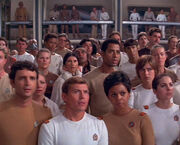
Many Starfleet members of various species
Starfleet has always been a multiracial organization, composed of species from various worlds. Even though Starfleet was an organization representing United Earth, and later, the United Federation of Planets, it was not a requirement for Starfleet personnel to be Human, or later on, from a member species of the Federation. (ENT: "Borderland"; TNG: "The Chase") Non-Federation citizens could join Starfleet, but in order to do so, a command-level officer had to submit a letter of recommendation on behalf of the individuals in question. (DS9: "Heart of Stone")
As an example, in 2369, there were seventeen representatives from non-Federation planets serving on the USS Enterprise-D. (TNG: "The Chase")
At times, Starfleet even allowed members from species that were its enemies to work as crew members, including the Klingon Worf during the Federation-Klingon War of the 2370s; Simon Tarses, who was part Romulan; and Seven of Nine, a liberated Borg drone. (DS9: "The Way of the Warrior"; TNG: "The Drumhead"; VOY: "Scorpion, Part II") In 2401, Elnor became the first full Romulan accepted into Starfleet Academy. (PIC: "The Star Gazer")
However, following the return of the USS Voyager to the Alpha Quadrant, Seven's request to officially join Starfleet was rejected, (PIC: "Hide and Seek") although Icheb, a young former Borg drone was allowed into Starfleet Academy while Voyager was in the Delta Quadrant, (VOY: "Imperfection") rising to the rank of Lieutenant and science officer on the USS Coleman before his death. (PIC: "Stardust City Rag") Seven was given a field commission in 2401 by Admiral Jean-Luc Picard (PIC: "Farewell") and became a Commander and the first officer of the USS Titan-A. (PIC: "The Next Generation") Following the Battle of Frontier Day, Seven was promoted to captain of the rechristened USS Enterprise-G. (PIC: "The Last Generation")
The following species have had members working for Starfleet:
- Abdon's species (DS9: "The Assignment")
- Aenar (SNW: "Strange New Worlds")
- Akoszonam (DIS: "Kobayashi Maru")
- The species of an alien female ensign aboard the USS Alhambra (LD: "Veritas")
- The species of an alien male ensign aboard the USS Alhambra (LD: "Veritas")
- The species of an alien operations division ensign aboard the USS Cerritos (LD: "Moist Vessel")
- The species of an alien sciences division ensign aboard the USS Cerritos (LD: "Dos Cerritos")
- The species of an alien officer aboard the USS Enterprise (Star Trek III: The Search for Spock)
- The species of an alien officer aboard the USS Enterprise-D (TNG: "Data's Day")
- The species of an alien officer aboard the USS Enterprise-D (TNG: "In Theory")
- The species of an alien doctor aboard the USS Kelvin (Star Trek)
- The species of an alien ensign aboard the USS Quito (LD: "Cupid's Errant Arrow")
- The species of an alien helmsman aboard the USS Relativity (VOY: "Relativity")
- The species of an alien first officer serving under Captain Elizabeth Shelby in 2381 (LD: "An Embarrassment Of Dooplers")
- The species of an alien officer aboard the USS Shenzhou (DIS: "The Vulcan Hello")
- The species of an alien admiral seen at Starfleet Headquarters in 2381 (LD: "The Stars At Night")
- The species of an alien bridge officer aboard the USS Titan (LD: "Kayshon, His Eyes Open")
- The species of an alien first officer aboard the USS Titan (LD: "Strange Energies")
- The species of an alien special services officer aboard the USS Titan-A (PIC: "The Last Generation")
- Alnschloss K'Bentayr's species (Star Trek)
- Andorians (Star Trek IV: The Voyage Home)
- Antarans (LD: "Second Contact")
- Arcturians (Star Trek: The Motion Picture)
- Argosians (DS9: "Dax")
- Arkenites (Star Trek IV: The Voyage Home)
- Aurelians (PRO: "Asylum")
- Bajorans (TNG: "Ensign Ro")
- Barzans (DIS: "Brother")
- Beluga whales (LD: "First First Contact")
- Benzites (TNG: "Coming of Age")
- Betazoids (TNG: "The First Duty")
- Betelgeusians (Star Trek: The Motion Picture)
- Bolians (TNG: "Conspiracy")
- Boslics (DS9: "Call to Arms")
- Brenari (PRO: "Mindwalk")
- Brikar (PRO: "Supernova, Part 2")
- Brunali (PIC: "Stardust City Rag")
- Caitians (TAS: "The Survivor")
- Cardassians (DIS: "Scavengers")
- Deltans (Star Trek: The Motion Picture)
- Denobulans (PRO: "Asylum")
- Edosians (TAS: "One of Our Planets Is Missing")
- Efrosians (Star Trek IV: The Voyage Home)
- Elaysians (DS9: "Melora")
- Exocomps (LD: "No Small Parts")
- Ferengi (DS9: "Heart of Stone")
- Haliians (TNG: "Aquiel")
- Hornish (DIS: "Coming Home")
- Humans (TOS: "The Cage")
- Human Augment hybrid, Dal R'El (PRO: "Supernova, Part 2")
- Humpback whales (PRO: "Into the Breach, Part II")
- Illyrians (SNW: "Ad Astra per Aspera")
- Kaelons (LD: "Veritas")
- Kelleruns (DIS: "Red Directive")
- Kelpiens (DIS: "The Vulcan Hello")
- Klingons (TNG: "Encounter at Farpoint")
- K'normians (Star Trek: The Motion Picture)
- Ktarian-Human hybrid, Naomi Wildman (LD: "Dos Cerritos")
- Kzinti (LD: "Mugato, Gumato")
- Lanthanites (SNW: "The Broken Circle")
- Lurians (PRO: "Into the Breach, Part I")
- Medusans (PRO: "Supernova, Part 2")
- Megazoids (Star Trek VI: The Undiscovered Country)
- Mellanoid slime worms (PRO: "Supernova, Part 2")
- Merp's species (LD: "Second Contact")
- Migleemo's species (LD: "Crisis Point")
- Moxy's species (LD: "Terminal Provocations")
- Napeans (DS9: "Explorers")
- Nara's species (TNG: "Eye of the Beholder")

- Nonnikcam (PIC: "The Next Generation")
- Orions (LD: "Second Contact")
- Osnullus (DIS: "The Butcher's Knife Cares Not for the Lamb's Cry")
- Pelians (TNG: "The First Duty")
- Phylosians (LD: "Cupid's Errant Arrow")
- Pon Darra's species (LD: "Second Contact")
- Rhaandarites (Star Trek: The Motion Picture)
- Rhomsew's species (PIC: "Maps and Legends")
- Rigelians (LD: "Much Ado About Boimler")
- Romulans (PIC: "The Star Gazer")
- Rotciv (Star Trek VI: The Undiscovered Country)
- Saurians (Star Trek: The Motion Picture)
- Schlerm (DIS: "Kobayashi Maru")
- Soong-type android, Data (TNG: "Encounter at Farpoint")
- Tamarians (LD: "Kayshon, His Eyes Open")
- Tellarites (DS9: "Apocalypse Rising")
- Tiburonians (DS9: "The Ship")
- Trill (DS9: "Emissary")
- Tyrellians (TNG: "Starship Mine")
- Vau N'Akat (PRO: "Ouroboros, Part II")
- Vilix'pran's species (DS9: "Heart of Stone")
- Volis' species (LD: "Second Contact")
- Vulcans (TOS: "The Immunity Syndrome")
- Worene's species (Star Trek: The Motion Picture)
- Xindi-Arboreal (PRO: "Last Flight of the Protostar, Part I")
- Zaldans (TNG: "Coming of Age")
- Zaranites (Star Trek: The Motion Picture)
In addition, the Arkarians provided baryon sweeps for Starfleet starships, and Bynars provided their technical services in upgrading the computers of Starfleet ships. (TNG: "11001001", "Starship Mine") Starfleet also employed sentient artificial photonic lifeforms as holographic emergency personnel, such as the Emergency Medical Holographic programs. The El-Aurian Guinan provided her services as bartender on the Enterprise-D, while the Talaxian-Mylean hybrid Neelix, the Ocampa Kes, the liberated Borg Seven of Nine, and the Brunali former Borg drone Icheb worked as crew members of the USS Voyager during her voyage through the Delta Quadrant. (TNG: "The Child"; VOY: "Caretaker", "Scorpion, Part II", "Imperfection")
Furthermore, the Denobulan Doctor Phlox served as chief medical officer aboard the Enterprise NX-01 during the Interspecies Medical Exchange of the 22nd century. (ENT: "Broken Bow") At least two Pandronians had also been affiliated with Starfleet, to varying degrees: Honorary Commander Ari bn Bem, who briefly served as an independent observer aboard the USS Enterprise in 2270; and Shari yn Yem, who was employed by Starfleet as a drill instructor until 2381. (TAS: "Bem"; LD: "I, Excretus")
Individuals of other species sometimes served in Starfleet while disguising their true nature. For example, Una Chin-Riley, an Illyrian, initially hid her background to serve in Starfleet, due to the Federation ban on genetically engineered individuals such as herself. However, Una later turned herself in, and, following a trial, was granted asylum, allowing her to serve openly in Starfleet. (SNW: "Ghosts of Illyria", "Ad Astra per Aspera")
Dal R'El, due to his status as a Human Augment hybrid, was not eligible for Starfleet because of the ban against Augments. However, Vice Admiral Kathryn Janeway successfully lobbied on Dal's behalf, particularly as Dal's physiology was made up of member species of the Federation itself. Dal was allowed to become a warrant officer in-training under Janeway's command, attended a Starfleet Academy prep school, and was eventually given a field commission as an ensign in Starfleet. (PRO: "Mindwalk", "Supernova, Part 2", "Into the Breach, Part I", "Ouroboros, Part II")
In other cases, hostile infiltrators disguised themselves as members of known Federation-aligned species, sometimes for extended periods of time, in order to covertly perform espionage or sabotage from within Starfleet's ranks. Examples include the Changeling who impersonated the Human Julian Bashir, and Asencia, a Vau N'Akat who posed as a Trill. (DS9: "In Purgatory's Shadow"; PRO: "Masquerade") In a few instances, Terrans, the mirror universe counterparts of Humans, served in Starfleet by disguising themselves as their counterparts. However, some refugees who escaped the mirror universe also served in Starfleet as Humans without concealing their origins. (DIS: "Vaulting Ambition", "The War Without, The War Within", "Mirrors")
According to Ron D. Moore, the apparent predominance of Humans in Starfleet was due to budgetary reasons, and he presumed it to be far more heterogeneous than could normally be shown. (AOL chat, 1997)
Alternate timelines and realities[]
- The species of an alien bearded crewmember aboard the USS Enterprise in the alternate reality (Star Trek)
- The species of an alien female cadet at Starfleet Academy in the alternate reality (Star Trek)
- The species of an alien male cadet at Starfleet Academy in the alternate reality (Star Trek)
- The species of an alien communications officer aboard the USS Enterprise in the alternate reality (Star Trek)
- The species of an alien crewman aboard the USS Enterprise in the alternate reality (Star Trek)
- The species of an alien engineering officer aboard the USS Enterprise in the alternate reality (Star Trek Into Darkness)
- The species of an alien operations crewmember aboard the USS Enterprise in the alternate reality (Star Trek Beyond)
- The species of an alien torpedo bay cadet aboard the USS Enterprise in the alternate reality (Star Trek)
- Bezos' species (Star Trek Beyond)
- Co-Co's species (Star Trek Beyond)
- Jae's species (Star Trek Beyond)
- Jeanine's species (Star Trek Beyond)
- Jin's species (Star Trek Beyond)
- Keenser's species (Star Trek)
- Madeline's species (Star Trek)
- Moto's species (Star Trek Into Darkness)
- Satine's species (Star Trek Beyond)
- Shaku's species (Star Trek Into Darkness)
- Shazeer's species (Star Trek Beyond)
- Sir Olden's species (Star Trek Beyond)
- Syl's species (Star Trek Beyond)
- Teenaxi (Star Trek Beyond)
- Tyvanna's species (Star Trek Beyond)
- Wadjet's species (Star Trek Beyond)
- Xindi (ENT: "Azati Prime")
Organization[]
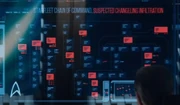
Overview of command structure
The president of the United Federation of Planets was the supreme authority of all Federation forces, including Starfleet. (DS9: "Homefront", "Paradise Lost", "Extreme Measures", Star Trek VI: The Undiscovered Country)
In addition, the Federation Council, the Federation's legislature, had much sway over Starfleet's budget and operations. (TNG: "Force of Nature", "The Defector")
Commander in chief[]
The commander in chief (abbreviated C-in-C or CNC) was the head and senior-most officer of Starfleet. The CNC was responsible for directing the organization's day-to-day operations, overseeing Starfleet Command and granting commissions to officers. The commander in chief directly reported to the Federation president. (Star Trek VI: The Undiscovered Country)
| Portrait | Commander in Chief | Tenure | Reference |
|---|---|---|---|
| Fleet Admiral Gene Roddenberry |
ca. 2240s–ca. 2293 | DIS: "The Vulcan Hello" | |
 |
Fleet Admiral Bill |
2293 | Star Trek VI: The Undiscovered Country |
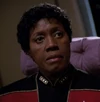 |
Fleet Admiral Taela Shanthi |
2368 | TNG: (citation needed • edit) |
 |
President Jaresh-Inyo |
2370 | DS9: "Paradise Lost" |
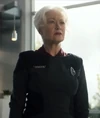 |
Fleet Admiral Kirsten Clancy |
2399 | PIC: "Maps and Legends" |
 |
Fleet Admiral Charles Vance |
3189 | DIS: "Die Trying" |
Starfleet Command[]
The Starfleet Command was the senior leadership of Starfleet. Starfleet Command assigned missions to officers and supervised the sector commands as well as other constituent services of Starfleet such as Starfleet Academy. Noticeable positions included the Commander, Starfleet, the commanding officer of Starfleet Command (such as Robert L. Comsol), the chief of staff and the chief of Starfleet Operations. (Star Trek III: The Search for Spock; TOS: "The Menagerie, Part I"; Star Trek IV: The Voyage Home; Star Trek V: The Final Frontier)
It is unclear precisely what exact functions these positions involved. Nor is it known, precisely, how they related to each other in terms of command authority.
Sector commands[]
The sector commands oversaw Starfleet operations within sectors of Federation space. There were at least 23 sector commands. Sector commanders reported to Starfleet Command, and commanding officers of service vessels operating within these sectors reported to them. Starbases and outposts located in the sector likewise fell under the purview of the sector command. (TNG: "Power Play", "The Measure Of A Man", DS9: "Whispers")
Operational forces[]
The operational forces were the main component of Starfleet. They primarily consisted of exploratory and military spacecraft. The starships of Starfleet comprised enlisted personnel, charged with executing orders, and commissioned officers, charged with issuing orders (although enlisted officers in supervisory positions and commissioned officers in non-supervisory positions also existed). Flag officers usually did not command individual starships. Starfleet vessels were led by a commanding officer (CO) or a first officer (XO), if the CO was unavailable.
While Starfleet often operated ships individually on solo missions, ships were also organized into larger fleets, most often during times of war. Fleets usually consisted of several hundred ships and were typically commanded by a vice admiral, although it appears to have been standard form to refer to a vice admiral in command of a fleet as a "fleet admiral", regardless of their actual rank. (TNG: "Redemption II", "Chain Of Command, Part I")
Vice admirals who have been referred to as "fleet admiral", apparently through virtue of their position, include admirals Alynna Nechayev and Shanthi
During the Dominion War, Starfleet operated a number of fleets, some of which, such as the Ninth Fleet, were combined allied fleets containing ships from both Starfleet and the Klingon Defense Force. Within fleets were various units known as attack wings (or tactical wings), often commanded by an admiral, or even a senior Captain. Captain Bennet was one such junior officer to command a tactical wing, commanding the Seventh Tactical Wing after being promoted to the position by Admiral William Ross. It was standard practice for a tactical wing commander to be assigned an adjutant. (DS9: "Behind the Lines", "Favor the Bold")
| Federation Alliance Fleets in the Dominion War |
|---|
| Second Fleet • Third Fleet • Fifth Fleet • Sixth Fleet • Seventh Fleet • Ninth Fleet • Tenth Fleet |
In some cases, for temporary or ad hoc missions, Starfleet vessels could be formed into battle groups. Star Fleet Battle Group Omega was one such formation, created to stop a Reman attack on Earth. In the 23rd century, temporary forces of this nature were known simply as "attack forces" and commanded by a commodore. By the 24th century, the term task force had become more common to describe smaller starship groups of this nature. (Star Trek Nemesis, TOS: "The Ultimate Computer", TNG: "Redemption II")
Starfleet Academy[]

Starfleet Academy seal
Starfleet Academy was a institution maintained for the training of its officers. Prospective officers received extensive training at this facility for a period of four years, some serving aboard starships near the end of their education. Undergraduates attending the facility were called cadets, and were also known as midshipmen for a time in the 23rd century. Successful graduates were commissioned as Federation Starfleet officers. (TOS: "Court Martial"; TNG: "Tapestry"; DIS: "Will You Take My Hand?"; SNW: "Strange New Worlds")
Branches and agencies[]
There were a number of branches and agencies that made up the organizational substructure of Starfleet Command in the administration of the service.
- Judge Advocate General
- Office of the Inspector General
- Spaceframe Development
- Starfleet Administration
- Starfleet Advanced Technologies
- Starfleet Bureau of Information
- Starfleet Cartography
- Starfleet Corps of Engineers
- Starfleet Diplomatic Corps
- Exploratory Division
- Starfleet Intelligence
- Starfleet Materiel Supply Command
- Starfleet Medical
- Starfleet Mission Operations
- Starfleet Operational Support Services
- Starfleet Operations
- Starfleet Orbital Operations
- Starfleet Research
- Starfleet Shipyards Operations
- Starfleet Science
- Starfleet Security
- Stellar Imaging Division
- Starfleet Tactical
Personnel[]
Starfleet personnel were organized, using a naval-derived rank structure, into a chain of command. (TNG: "A Matter Of Honor", etc.) Personnel were in either of two groups: enlisted personnel and officers. (TNG: "Family", etc)
Some personnel formally committed to the service by taking the Starfleet oath.
Officers[]
In the 22nd century, Starfleet was a civilian organization acting as a successor to various Earth based space agencies such as NASA, the International Space Agency, and others. Its primary function was scientific development and exploration of space.
Starfleet officers functioned as commanders and directors of the service's operations at all levels. The most senior officers ranks were known as flag officer ranks. Officers holding these ranks functioned at the highest levels of command in the service. Flag officer ranks, in descending order of the chain of command, were as follows:
Sector commanders, the superintendent of Starfleet Academy, the Commander, Starfleet, the Starfleet chief of staff and chief of Starfleet Operations, and the commander in chief, were all flag officers. (Star Trek III: The Search for Spock; Star Trek IV: The Voyage Home; Star Trek V: The Final Frontier; TNG: "Ménage à Troi", "The First Duty")
Below flag officer ranks were other officer ranks. Officers holding these ranks usually served in field command positions, such as commanding officers and senior staff on the service's vessels. These ranks, in descending order of the chain of command, were as follows:
Graduates of Starfleet Academy were commissioned to the rank of ensign, the most junior officer rank, and were promoted to higher ranks over the courses of their time in the service. Physicians who graduated from Starfleet Medical Academy in the 24th century were commissioned to the rank of lieutenant junior grade. (DS9: "Emissary", etc.)
Enlisted personnel[]
These personnel functioned under the command of the officers, usually serving aboard Starfleet vessels or other facilities. Instead of officers' training, enlisted personnel received basic training for whatever position they served in. (VOY: "Good Shepherd", et al.) A known school for training enlisted personnel was the Starfleet Technical Services Academy on Mars. (LD: "Reflections") The most junior enlisted rank was that of crewman. The service's enlisted rank structure, in descending order of the chain of command, was as follows:
- Master chief petty officer
- Senior chief petty officer
- Chief petty officer
- Petty officer
- 1st class
- 2nd class
- 3rd class
- Crewman
The enlisted ranks above that of crewman were not commissioned officer ranks. To distinguish them from commissioned officer ranks, the term 'non-commissioned officer' was used. It was also common to refer to any enlisted Starfleet member in the generic title of "Crewman", while also substituting the terms "Specialist" and "Technician" when mentioning the said crewman in a log entry. (TOS: "Space Seed")
All enlisted personnel were subordinate to commissioned officers in the chain of command, however senior enlisted personnel were occasionally assigned junior officers as specialists and technicians. (TNG: "Clues")
It was also possible for an enlisted Starfleet member to be appointed as a department head, in which case they were designated the same authority as a fully commissioned officer, including staffs of both officers and enlisted under their command. (TNG: "The Wounded", "Redemption II", DS9: "Emissary", "The Ship")
In addition to their actual ranks, Starfleet enlisted personnel also held titles known as "rates" which were used to describe an occupational specialty. Some rates in use during the 23rd century were the rates of Yeoman and Engineer's mate. It was also possible for an enlisted crewman to hold a grade or class, such as John B. Watkins, who was an Engineer, Grade 4, as well as Tina Lawton, who was a Yeoman, 3rd Class. The use of rates continued into the 24th century, with Tal Celes holding the rating of Sensor analyst, Grade 3, while serving onboard the USS Voyager. (TOS: "Charlie X", "A Taste of Armageddon", "That Which Survives", VOY: "Good Shepherd")
The use of Starfleet rates was confined mainly to Star Trek: The Original Series, with "Yeoman" by far being the most commonly mentioned rate throughout the series. By the time of Star Trek: The Next Generation, little mention is made of enlisted rates, although through the development of the Miles O'Brien character, who was an expert in transporter technology, it is clear Starfleet still specialized enlisted personnel within certain career fields.
Career Progression[]
Career advancement within Starfleet was very much up to the individual Starfleet member, based on their own personal motivations, career plans, and future goals. Although there were certain promotions and assignments, such as that of starship commander, which were considered highly prestigious and competitive, in most cases a Starfleet member advanced through their career by requesting certain assignments in their particular field of interest. In the case of starship duty, a Starfleet member would "sign on" to a particular starship, with some ships having long waiting lists for those wishing to serve. (TOS: "Space Seed", TNG: "Ensign Ro")
Starfleet members who committed serious errors or infractions while on duty could be reprimanded, and oftentimes this would prevent advancement into higher postings or promotion to senior ranks. Such was the case of Lieutenant Commander Benjamin Finney, who was sent to the bottom of the promotion list after leaving a circuit open to an atomic matter pile. (TOS: "Court Martial")
Officers could also refuse promotion, as was often the case of starship captains, as well as department level commanders onboard larger vessels, who felt that promotion to higher rank, or transfer to a lesser-known ship, would be less beneficial to their careers. William T. Riker, who eventually served as captain of the USS Titan, had turned down three previous promotion offers to captain smaller vessels. (TNG: "The Arsenal of Freedom", "The Icarus Factor", "The Best of Both Worlds")
In the 23rd century, a procedure existed that if a Starfleet Admiral took command of a single starship, they would revert to the rank of Captain, displacing the current Captain who then reverted to the rank of Commander. By 2285, this practice appears to have no longer been in place, given that when Admiral James T. Kirk assumed command of the USS Enterprise, he continued to be addressed as an Admiral and wear a flag officer's uniform, this having not been the case when he similarly had assumed command of the same ship in the 2270s. (Star Trek: The Motion Picture, Star Trek II: The Wrath of Khan)
By the 24th century, Starfleet allowed some career fields to "set their own pace" and if an officer wished, they could remain in a lower rank and position for decades. Jean-Luc Picard witnessed this in an alternate timeline where, with no career goal, he had remained a lieutenant junior grade and assistant astrophysics officer apparently for over forty years. Starfleet enlisted positions could also be used by civilians wishing to gain practical space experience, without any thought of promotion or advancement, such as in the case of Crewman Mortimer Harren. (TNG: "Tapestry", VOY: "Good Shepherd")
Promotions of junior officers onboard starships was often based on the availability of open positions, such as that of duty operations officer, which allowed a qualified ensign to assume the rank of lieutenant. On some starships, lieutenants so promoted were permitted to have their own quarters. (TNG: "Lower Decks")
Uniforms[]
In the 22nd century, the same basic uniform was worn by all Starfleet officers, with differences in insignia and color-coded elements designed to distinguish rank and departmental function. Starfleet departments included Starfleet Operations and Starfleet Security. (ENT: "Broken Bow")
Starfleet personnel wore distinctive uniforms while on duty. These uniforms generally displayed the department color of the department/division the enlisted person or officer served in, and also the rank insignia.
Wearing a Starfleet uniform when not actually a member of Starfleet would put one at risk of being charged with impersonating a Starfleet officer. (DS9: "Chrysalis")
Bases and installations[]
Aside from its headquarters, located on Earth, the Federation's capital world, Starfleet also maintained installations throughout Federation territory.
Starbases[]
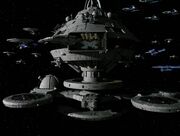
Starbases were facilities set aside for resupply of the service's vessels and the relaxation of vessel crews, were maintained in all sectors of Federation space. In addition, the service also maintained facilities beyond Federation territory. The most well-known of these is Deep Space 9, in the Alpha Quadrant. (Star Trek: Deep Space Nine)
By 2385, there were major starbases in the Alpha, Beta, and Gamma Quadrants. (PRO: "Ouroboros, Part I")
Shipyards[]

The Utopia Planitia Fleet Yards
The service also maintained a number of shipyards at which it constructed its vessels and designed and tested new vessels and vessel types. Among the most famous of these shipyards were:
- The Utopia Planitia Fleet Yards, located in orbit around Mars
- The San Francisco Fleet Yards, located in orbit around Earth
- The Beta Antares Ship Yards, located in the Antares sector
(TNG: "Parallels", "Eye of the Beholder", "Night Terrors", "The Wounded"; Star Trek: The Motion Picture; VOY: "Message in a Bottle")
Training facilities[]

Relva VII testing facility
Apart from Starfleet Academy, the service also maintained several training facilities for both officers and enlisted personnel. These included a number of Academy annexes, located in different systems. Known annexes were Starfleet Academy (Beta Aquilae II), Starfleet Academy (Beta Ursae Minor II), and Starfleet Academy (Psi Upsilon III). (TNG: "Eye of the Beholder")
The service also maintained at least one testing facility to evaluate prospective Starfleet Academy undergraduates for admission into the academy. This facility was located on the planet Relva VII. (TNG: "Coming of Age")
Starfleet Academy also had a training program for enlisted personnel. (TNG: "The Drumhead"; DS9: "Trials and Tribble-ations")
In addition, at least one other such facility was located on Mars, known as the Starfleet Technical Services Academy. (TNG: "Eye of the Beholder")
Vessels[]
Starships[]
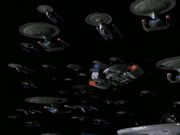
A task force of Starfleet starships prepares for battle
The backbone of Starfleet's operations was its fleet of starship. These vessels, all warp-capable, helped to carry out the service's mandates: exploration, the defense of the Federation, the transport of supplies and resources, and emergency medical care. A large range of starship classes existed. Some were multi-purpose and others were designed for a specific use. (citation needed • edit)
The United Earth Starfleet did not have any jurisdiction over what happened aboard vessels operating in the Earth Cargo Service. That responsibility remained in the hands of the Earth Cargo Authority. (ENT: "Fortunate Son", "Horizon")
By 2257, there were seven thousand active ships in Starfleet. (DIS: "Perpetual Infinity")
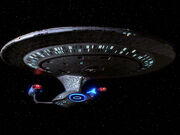
Galaxy-class
At its launch, the Galaxy-class, primarily designed at the Utopia Planitia Fleet Yards, was the most technologically sophisticated in the history of the service. (TNG: "Lonely Among Us", "Contagion") Vessels of this class were the largest in size of any ever produced in Federation history, and became well-known, both within and outside of the Federation, for their capabilities in both scientific inquiry and exploration. (TNG: "Tin Man", "Chain Of Command, Part I"; DS9: "Valiant")
By the late 24th century, Starfleet had developed a stance in opposition of the use of warships. Despite this, several ostensible warships were developed and brought into service by Starfleet during the 2360s and 2370s in response to the Borg and Dominion threats. (DS9: "The Search, Part I")
Starfleet starships had navigational lights, red on the port (left) and green on the starboard (right), fitted to the hull. These have been seen on vessels from the late 22nd century to the late 24th century. (Star Trek: Enterprise (citation needed • edit); Star Trek VI: The Undiscovered Country, Star Trek Generations, Star Trek Nemesis)
Other vessels[]
Aside from its starships, the service also operated other vessels. Among these were several types of shuttlecraft, which were typically used to transport personnel over relatively short distances, such as from a starship orbiting a planet down to the planet's surface. (ENT: "Chosen Realm", et al.)
Starfleet shuttlecraft of the 23rd and 24th centuries also were equipped with limited warp capability, allowing transport of personnel within a range of several light years from the starship. (VOY: "Initiations", "Tsunkatse", "Good Shepherd")
Time vessels[]
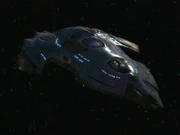
The Wells-class
Interventions by Starfleet of the 29th century into the 24th century revealed vessels that the service used in that time. In this century, Starfleet had yet another mandate: to safeguard the timeline. Thus it operated vessels that were able to routinely traverse through time. These vessels were called timeships.
Classes of these vessels included the Wells-class and the Model HB-88.
General Orders and Regulations[]
The service maintained a set of regulations, known as General Orders and Regulations. These governed all aspects of service operations and covered all possible situations it was thought that personnel might encounter, from protocol to situations of first contact with unknown species.
The most important of these was termed General Order Number One, but was more commonly referred to as the Prime Directive.
Not all of the general orders and regulations were intended for general personnel knowledge. At least one, known as the Omega Directive, was a top secret of the highest order, and was known only to officers ranking captain or any flag officer rank. This was due to the extreme sensitivity and danger posed by the subject the directive dealt with. (VOY: "The Omega Directive")
Opinions[]
According to Christopher Pike, as of 2255, Starfleet had become too cautious. In a conversation with James T. Kirk, the captain compared Kirk to his father, recalling, "You know, that instinct to leap without looking, that was his nature too, and in my opinion, it's something Starfleet's lost." (Star Trek)
Appendices[]
See also[]
- Starfleet insignia
- Starfleet ranks
- Starfleet personnel
- Starfleet uniforms
- Starfleet captains
- Starfleet flag officers
- Starfleet yearbook
- Federation starships
- Federation starship classes
- Federation shuttlecraft
- Federation shuttlecraft classes
- Federation Naval Patrol
- Merchant Marines
- Starfleet Mission Control
- NX test program
Background information[]
The first episode whose production incorporated the terms "Starfleet" and "Starfleet Command" was TOS: "Court Martial". However, the final draft and a revised final draft of that episode's script (dated 26 and 29 September 1966 respectively) used the term "Galactic Command" instead of "Starfleet Command". By comparison, the term "Starfleet" was extensively used in the final draft script of "The Menagerie" (issued in October 1966). In terms of air date too, that name as well as "Starfleet Command" debuted in "The Menagerie, Part I" (which aired 17 November 1966), though the term "Star Service" and "Spacefleet Command" were later used in "The Conscience of the King" (broadcast on 29 September 1966) and "The Squire of Gothos" (aired 12 January 1967) respectively, prior to the initial airing of "Court Martial" (on 2 February 1967). Another early variant of the organization's name was "Space Central" in "Miri", which preceded all those episodes in both airing and production order (broadcast on 27 October 1966).
Additional early nomenclature used to describe Starfleet included: Space Command in TOS: "The Man Trap" and "Court Martial", and Space Service in TOS: "Balance of Terror".
Military[]
The extent to which Starfleet may be considered a military organization is somewhat questionable. Nicholas Meyer remarked of Starfleet's militarism, "It existed to some extent in the [original] television series but Gene Roddenberry was very adamant that the Starfleet was not a military or a militaristic operation […] I thought it was at least as militaristic as, say, the Coast Guard." (audio commentary, Star Trek VI: The Undiscovered Country (Special Edition) DVD) Meyer also wrote about these ideological differences in his autobiographical book The View from the Bridge. Therein, he recalled, "[Roddenberry] was emphatic that Starfleet was not a military organization but something akin to the Coast Guard. This struck me as manifestly absurd, for what were Kirk's adventures but a species of gunboat diplomacy wherein the Federation (read America, read the Anglo-Saxons) was always right and aliens were – in Kipling's queasy phrase – 'lesser breeds'? Yes, there was lip service to minority participation, but it was clear who was driving the boat." (The View from the Bridge, hardcover ed., p. 81) On another instance, Meyer observed that, beginning with Star Trek II: The Wrath of Khan (which Meyer himself directed), later Star Trek productions placed more emphasis on the militaristic perspective of Starfleet than the original series had. (audio commentary, Star Trek VI: The Undiscovered Country (Special Edition) DVD) However, in Star Trek: The Next Generation, Roddenberry was determined to downplay the more militaristic aspects of Starfleet. (Star Trek: The Next Generation - The Continuing Mission, p. 36) Those who were uncomfortable about Starfleet being depicted in a militaristic fashion in Star Trek II included not only Roddenberry but also Uhura actress Nichelle Nichols. In her book Beyond Uhura (hardcover ed., p. 248), she stated, "Portraying Starfleet as a military organization flew in the face of everything Star Trek stood for […] At one point I forcefully but tactfully reminded Meyer and Harve [Bennet] that Starfleet was the philosophical descendant of NASA, not the Air Force."
Regardless of Roddenberry's non-militaristic intent, it had been abundantly obvious that he did pattern his Starfleet, both in organization and in traditions, after the real world, militaristic United States Navy (The Making of Star Trek, p. 112, et al.; These Are the Voyages: TOS Season One, 1st ed, pp. 28-29; see also in this respect: Aircraft carrier & Federation starship class naming conventions), something he, the World War II USAAF veteran, reaffirmed in a later 1973 radio interview where he had declared that he had always been "fascinated by the Navy". [1] [2] Incidentally, Roddenberry's right hand on the Original Series, Robert H. Justman, and who had helped him to beef out the Starfleet concept, had served in the US Navy during the war.
A line included in the script for Star Trek VI: The Undiscovered Country but not in the actual film was to have established that Starfleet was under civilian control, such that certain interstellar choices (for instance, whether to aid the Klingon Empire in avoiding economic collapse or to hamper the Empire, eventually causing them to become subservient to Starfleet) were entirely political rather than military decisions.
Ronald D. Moore commented, "I've always felt that Starfleet is the military / exploratory / scientific arm of the UFP." (AOL chat, 1997) However, the Federation has never been shown to have a standing army. In "Peak Performance", Captain Picard states, "Starfleet is not a military organization, its purpose is exploration.". Moore also explicitly compared it to a military: "Say Starfleet isn't the military all you want, it fails the duck test – looks like, walks like, sounds like, etc." (AOL chat, 1997)
Remarking on a Starfleet JAG getting involved with a civilian case with Richard Bashir, Moore said, "Starfleet is more than just a military entity and seems to have police and/or judicial functions." (AOL chat, 1997)
Writers Roberto Orci, Alex Kurtzman, and Damon Lindelof tackled the theme of militarization head on in Star Trek Into Darkness. "After what happened to Vulcan, after Earth gets attacked, would Starfleet say, 'well, we dodged that bullet, back to exploration?' Or would they say 'we have to prepare ourselves if this ever happens again.' What would a more militarized Starfleet look like? Ultimately, the story would be about that, and for the soul of Starfleet." [3]
Size[]
Regarding the quantity of starships Starfleet had in use in the late 2370s, Moore commented, "I wouldn't be surprised if Starfleet had 30,000 ships or so." (AOL chat, 1997) This was based on reasoning that the USS Hood has a registry of NCC-42296 while the USS Voyager is NCC-74656.
During Operation Return, Starfleet attempted to prevent the Dominion from bringing down the minefield, which would have allowed 2,800 ships to come through the wormhole, which would allow for a Dominion total victory. This would indicate that, at that time of the war, the forces of both sides were about equal, the true size of the Dominion forces was much larger than Starfleet.
Doctor Zimmerman claimed that there were 675 EMH Mark I installations active in Starfleet before they were taken off duty during the Dominion War. (VOY: "Life Line")
According to Control, Starfleet consisted of approximately seven thousand active ships in service during the mid-2250s. (DIS: "Perpetual Infinity")
Trivia[]
A developmental note, handwritten by Jeri Taylor and dated July, concerned Starfleet's role in Star Trek: Voyager. It read, "Messages to Starfleet – one way." (Star Trek: Voyager - A Vision of the Future, p. 175)
In the reference book Beyond the Final Frontier (p. 381), critics Mark Jones and Lance Parkin made an observation about how Starfleet was depicted in Star Trek: Enterprise; they commented, "The sense of Starfleet being made up of pioneering, rather cocky test pilots is something that the show could use more of."
External links[]
- Federation Starfleet at Memory Beta, the wiki for licensed Star Trek works
- United Earth Starfleet at Memory Beta, the wiki for licensed Star Trek works
- Starfleet at Wikipedia

